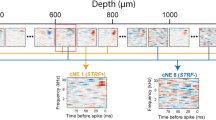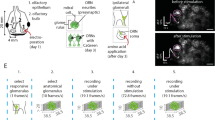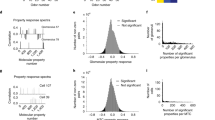Abstract
We used neural ensemble recording to examine odor-evoked ensemble patterns in the moth antennal (olfactory) lobe. Different odors are thought to evoke unique spatiotemporal patterns of glomerular activity, but little is known about the population dynamics underlying formation of these patterns. Using a silicon multielectrode array, we observed dynamic network interactions within and between glomeruli. Whereas brief odor pulses repeatedly triggered activity in the same coding ensemble, the temporal pattern of synchronous activity superimposed on the ensemble was neither oscillatory nor odor specific. Rather, synchrony strongly depended on contextual variables such as odor intensity and intermittency. Also, because of emergent inhibitory circuit interactions, odor blends evoked temporal ensemble patterns that could not be predicted from the responses to the individual odorants. Thus even at this early stage of information processing, the timing of odor-evoked neural representations is modulated by key stimulus factors unrelated to the molecular identity of the odor.
This is a preview of subscription content, access via your institution
Access options
Subscribe to this journal
Receive 12 print issues and online access
$209.00 per year
only $17.42 per issue
Buy this article
- Purchase on Springer Link
- Instant access to full article PDF
Prices may be subject to local taxes which are calculated during checkout





Similar content being viewed by others
References
Hildebrand, J. G. & Shepherd, G. M. Mechanisms of olfactory discrimination: converging evidence for common principles across phyla. Annu. Rev. Neurosci. 20, 595– 631 (1997).
Christensen, T. A. & White, J. in The Neurobiology of Taste and Smell Vol. 2 (eds. Finger, T. E., Silver, W. L. & Restrepo, D.) (Wiley, New York, in press).
Rodrigues, V. Spatial coding of olfactory information in the antennal lobe of Drosophila melanogaster. Brain Res. 453, 299– 307 (1988).
Joerges, J., Küttner, A., Galizia, G. & Menzel, R. Representations of odours and odour mixtures visualized in the honeybee brain . Nature 387, 285–288 (1997).
Distler, P. G., Bausenwein, B. & Boeckh, J. Localization of odor-induced neural activity in the antennal lobes of the blowfly Calliphora vicina: a [3H]2-deoxyglucose labeling study. Brain Res. 805, 263– 266 (1998).
Murlis, J. in Insect Pheromone Research – New Directions (eds. Carde, R. T. & Minks, A. K.) 221–231 (Chapman & Hall, New York, 1997).
Christensen, T. A. & Hildebrand, J. G. Coincident stimulation with pheromone components improves temporal pattern resolution in central olfactory neurons. J. Neurophysiol. 77, 775–781 (1997).
Hansson, B. S. & Christensen, T. A. in Insect Olfaction (ed. Hansson, B. S.) 125–161 (Springer, Berlin, 1999).
Stopfer, M., Wehr, M., MacLeod, K. & Laurent, G. in Insect Olfaction (ed. Hansson, B. S.) 163–180 (Springer, Berlin, 1999).
Christensen, T. A., Waldrop, B. R., Harrow, I. D. & Hildebrand, J. G. Local interneurons and information processing in the olfactory glomeruli of the moth Manduca sexta. J. Comp. Physiol. A 173, 385–399 (1993).
Nicolelis, M. A. L. Methods for Neural Ensemble Recordings (CRC, New York, 1999).
Heinbockel, T., Christensen, T. A. & Hildebrand, J. G. Temporal tuning of odor responses in pheromone-sensitive projection neurons in the brain of the sphinx moth Manduca sexta. J. Comp. Neurol. 409, 1–12 (1999).
King, J. R., Christensen, T. A. & Hildebrand, J. G. Response characteristics of an identified, sexually dimorphic olfactory glomerulus. J. Neurosci. 20, 2391–2399 (2000).
Christensen, T. A. & Hildebrand, J. G. Male-specific, sex pheromone-selective projection neurons in the antennal lobes of the moth Manduca sexta. J. Comp. Physiol. A 160, 553–569 (1987).
Mori, K. & Shepherd, G. M. Emerging principles of molecular signal processing by mitral/tufted cells in the olfactory bulb. Seminars Cell Biol. 5, 65–74 (1994).
Buonviso, N. & Chaput, M. A. Response similarity to odors in olfactory bulb output cells presumed to be connected to the same glomerulus: electrophysiological study using simultaneous single-unit recordings. J. Neurophysiol. 63, 447–454 (1990).
Rospars, J. P & Hildebrand, J. G. Anatomical identification of glomeruli in the antennal lobes of the male moth Manduca sexta. Cell Tissue Res. 270, 205–227 (1992).
Buonviso, N., Chaput, M. A. & Berthommer, F. Temporal pattern analyses in pairs of neighboring mitral cells. J. Neurophysiol. 68, 417– 424 (1992).
Rieke, F., Warland, D. & de Ruyter van Steveninck, Bialek, W. Spikes: Exploring the Neural Code (MIT Press, Cambridge, Massachusetts, 1997).
Kashiwadani, H., Sasaki, Y. F., Uchida, N. & Mori, K. Synchronized oscillatory discharges of mitral/tufted cells with different molecular receptive ranges in the rabbit olfactory bulb. J. Neurophysiol. 82, 1786–1792 (1999).
Gelperin, A. Oscillatory dynamics and information processing in olfactory systems. J. Exp. Biol. 202, 1855–1864 (1999).
Christensen, T. A., Waldrop, B. R. & Hildebrand, J. G. Multitasking in the olfactory system: context-dependent responses to odors reveal dual GABA-regulated coding mechanisms in single olfactory projection neurons. J. Neurosci. 18, 5999–6008 (1998).
Faber, T., Joerges, J. & Menzel, R. Associative learning modifies neural representations of odors in the insect brain. Nat. Neurosci. 2, 74–78 (1999).
Daly, K. C. & Smith, B. H. Associative olfactory learning in the moth Manduca sexta. J. Exp. Biol. (in press).
Hartlieb, E. Olfactory conditioning in the moth Heliothis virescens. Naturwissenschaften 83, 87–88 (1996).
Heinbockel, T., Kloppenburg, P. & Hildebrand, J. G. Pheromone-evoked potentials and oscillations in the antennal lobes of the sphinx moth Manduca sexta. J. Comp. Physiol. A. 182, 703–714 (1998).
Stopfer, M. & Laurent G. Short-term memory in olfactory network dynamics. Nature 402, 664– 668 (1999).
Aertsen, A. M. H. J., Gerstein, G. L., Habib, M. K. & Palm, G. Dynamics of neuronal firing correlation: modulation of “effective connectivity” . J. Neurophysiol. 61, 900– 917 (1989).
Acknowledgements
We are grateful to David Anderson and coworkers for providing microprobes and technical support, and we thank Carol Barnes and Bruce McNaughton for advice. We also thank Kevin Daly and Brian Smith for discussions and comments, and Heather Stein and A.A. Osman for technical assistance. Supported by grants and contracts from NIH/NIDCD and DARPA/CBS.
Author information
Authors and Affiliations
Corresponding author
Rights and permissions
About this article
Cite this article
Christensen, T., Pawlowski, V., Lei, H. et al. Multi-unit recordings reveal context-dependent modulation of synchrony in odor-specific neural ensembles. Nat Neurosci 3, 927–931 (2000). https://doi.org/10.1038/78840
Received:
Accepted:
Issue Date:
DOI: https://doi.org/10.1038/78840
This article is cited by
-
Olfactory coding in honeybees
Cell and Tissue Research (2021)
-
Network mechanism for insect olfaction
Cognitive Neurodynamics (2021)
-
Synchronous firing of antennal-lobe projection neurons encodes the behaviorally effective ratio of sex-pheromone components in male Manduca sexta
Journal of Comparative Physiology A (2013)
-
New vistas on honey bee vision
Apidologie (2012)
-
Balanced Olfactory Antagonism as a Concept for Understanding Evolutionary Shifts in Moth Sex Pheromone Blends
Journal of Chemical Ecology (2008)



